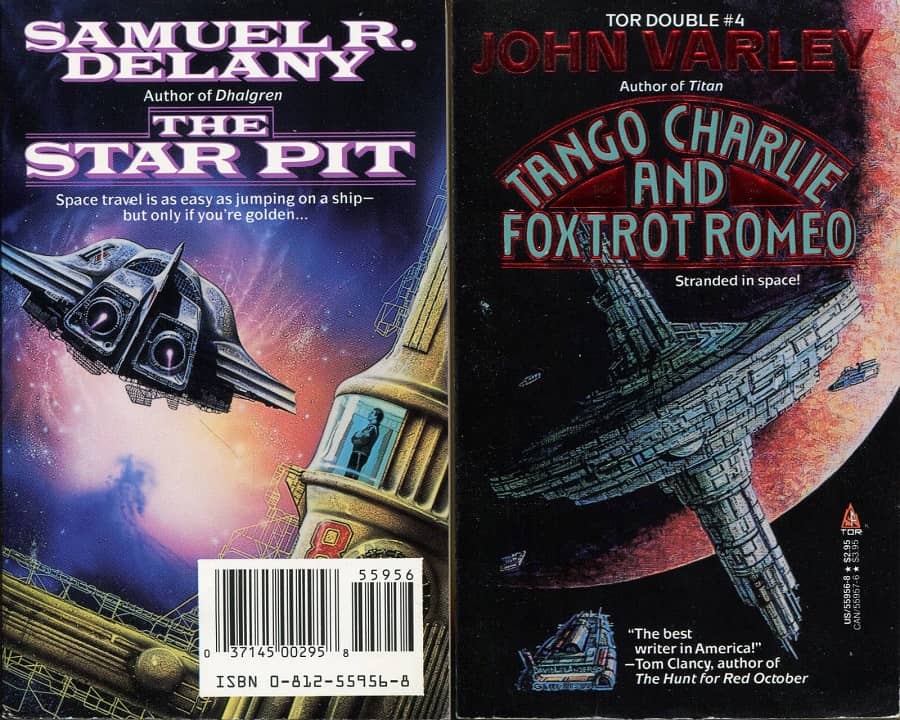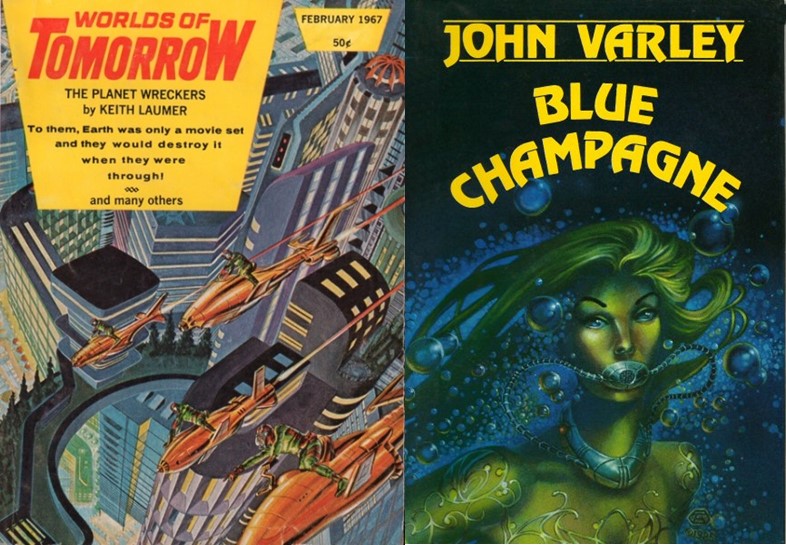Tor Doubles #4: Samuel R. Delany’s The Star Pit and John Varley’s Tango Charlie and Foxtrot Romeo

Cover for Tango Charlie and Foxtrot Romeo by David Lee Anderson
Originally published in January 1989, the fourth Tor Double included John Varley’s Tango Charlie and Foxtrot Romeo and Samuel R. Delany’s The Star Pit. Printed in the a tête-bêche format, David Lee Anderson provided the cover by Tango Charlie and Foxtrot Romeo and Tony Roberts was the artist for The Star Pit.
The Star Pit was originally published in Worlds of Tomorrow in February, 1967. It was nominated for the Hugo Award. It lost to Philip José Farmer’s “Riders of the Purple Wage” and Anne McCaffrey’s “Weyr Search,” which tied each other. Coincidentally, McCaffrey and Delany share a birthday.
Vyme, a mechanic at the titular Star Pit, serves as Delany’s narrator. Rather than start with the present day action, however, Vyme opens his narration with memories of his own childhood and his life from several years earlier. Born on the backwater Earth in New York, he talks about his childhood and the ant farm he had as a child, which would eventually break.
He also talks about his life after leaving earth participating in a procreation group, a futuristic group marriage which was meant to make child rearing easier for both parents and children. Mostly talking about his kid-boy Antoni, who had an ecologarium, a sort of ant farm on a larger scale, it is clear that at best, Vyme is an absentee father, using the structure of the procreation group to allow himself to travel off world to take jobs as a mechanic and nursing his alcoholism, which eventually leads to him abandoning his group marriage.
Eventually, Vyme sobers up, but not before he can no longer return to his group family. Instead, he is on a Star Pit, a way station in space which is used to dock and repair spaceships. He is aided in this by Sandy and a young prodigy, Ratlit, who at thirteen has written a novel despite being functionally illiterate. Ratlit also helps out Alegra, a drug-addicted girl two years older than he is.
Vyme, Ratlit, Sandy, and Alegra are living their lives on the Star Pit in a world which has significant space travel, but in order for it to happen, people need to be identified as “the golden,” individuals who can pilot starships and are the only ones who can travel beyond the galactic plane without going insane, although their sanity is in question in any event.
According the Vyme, the golden are stupid and mean and the details of his interactions with them certainly bear that out, as well as a certain pettiness and a parallel society which normal humans can only watch and not fully understand. When one golden kills another in Vyme’s shop, Vyme and Sandy take it in stride. The surviving golden claims ownership of the dead golden’s ship and, not wanting it, hands it over to Sandy.
The plot of The Star Pit, such as it is, is secondary to the characters and their relationships with each other. Despite Vyme’s paternal tendencies toward Ratlit and his mentoring of Sandy, or Ratlit taking care of Alegra and making sure she is being treated for her illnesses, none of the characters seem to particularly like each other. They have been thrown together by circumstances and deal with each other as best that can.
While Vyme presents his background at the beginning of the novella, the other characters’ stories are only slowly revealed, and, while Vyme is not necessarily an unreliable narrator, the explanation for Sandy, Ratlit, Alegra, and, eventually the young golden Androcles, are all viewed through Vyme’s point of view. When Androcles show sup looking for a job, it is clear that Vyme sees him, at least in part, as a surrogate for his own long lost son, Antoni.
There is a certain disjointedness to The Star Pit, perhaps representing the fact that Vyme is not entirely comfortable with his own position and the difficult relationships he has with Sandy and Ratlit, one of whom appears to represent his own failures and the other of whom represents the possibilities a young Vyme drank away and squandered.
The Star Pit postulates a galaxy in which humans have spread, but its tight focus makes the galaxy feel like a very small place. While the golden have the ability to travel, most humans are limited as to where they can go, which is a response and reaction to all the stories of galactic empires and humanity expanding throughout the galaxy and universe.
Rich Horton discussed The Star Pit in the essay “An Evocation of the Science Fiction Dream of Exploration: ‘The Star Pit’ by Samuel R. Delany” in Black Gate in December 2020.

Blue Champaign cover by Todd Cameron Hamilton
Tango Charlie and Foxtrot Romeo was originally published in the John Varley collection Blue Champagne by Dark Harvest Press in January, 1986. It won the Seiun Award in 1992.
Tango Charlie and Foxtrot Romeo was originally published in the John Varley collection Blue Champagne by Dark Harvest Press in January, 1986. It won the Seiun Award in 1992.
Like The Star Pit, Tango Charlie and Foxtrot Romeo takes place on an outpost, although it isn’t as distant as the one in Delany’s story. Instead, Varley’s focus is on a space station in orbit around Earth’s moon and the story opens with the remains of a dead dog being expelled through the station’s airlock, which is noted by a satellite which in stationed to track anything that comes out of the space station.
It turns out that the space station had been struck by a virus, Neuro X, thirty years earlier and quarantined. The expulsion of the dog is the first indication the Lunarians have that there is anything still alive on the space station. Varley story follows Anna-Louise Bach, a recruit/apprentice at the New Dresden Police Department on the moon and Charlie, a young girl who is living alone on the space station in the company of dozens of dogs.
The first half of the story deals with an assessment of the situation, Bach trying to figure out how to make contact with whoever might still be living on the space station and Charlie living her life surrounded by dogs and the station’s computer Tik-Tok, and becoming aware that someone is trying to contact her from the outside world. Eventually, contact is made and a resolution to the situation must be found. That resolution is made more difficult by information that Varley slowly reveals.
In the space of the novella, Varley creates three different societies to various degrees. The most obvious ones are the simple society that surrounds Charlie on the space station, with her interactions with the dogs, the chores that she must do, and the way she comes to terms with growing up. The second is the Lunarian society, which is clearly separate from that of Earth, beginning with fashion, but continuing to attitudes. Finally, Terrestrial culture is represented by Bach’s acquaintance Megan Galloway. Galloway is a celebrity on Earth who has a history that involves Bach. They don’t like each other, but find the can use each other to achieve their ends.
The nature of the story, following Charlie and her dogs and switching to follow Bach, means that Varley is essentially writing two intertwined stories. Charlie’s story is one of someone living on an abandoned space station, content and understanding of her world, until outside forces intrude and try to force their way of thinking on her. In many ways, Charlie is an alien race that the humans of Luna are attempting to colonize, although they wouldn’t see it that way.
The humans on Luna see themselves trying to understand the fate of a failed human colony on the Tango Charlie space station. The know that the disease that eradicated the station’s population could cause a deadly pandemic on the moon or Earth if it were released. At the same time, they have discovered that Charlie (and the dogs) have somehow managed to survive it and could offer hope for humanity if they could be studied. Unfortunately, the security system in place to make sure no contaminants escape the space station make it difficult to explore those possibilities.
As the novella progresses, Varley hints that something about Charlie may provide clues to either immortality or the impeding of aging. He also offers information about the nature of the Neuro X virus and the future of Tango Charlie, the space station upon which Charlie is resident. Some of the ideas Varley offers up in the story are seen to fruition while others are abandoned, leaving the story feeling a little unresolved, even as Varley does offer a resolution to most of his plot points. This also means that Tango Charlie and Foxtrot Romeo feels like it is part of a larger world.
 Steven H Silver is a twenty-one-time Hugo Award nominee and was the publisher of the Hugo-nominated fanzine Argentus as well as the editor and publisher of ISFiC Press for eight years. He has also edited books for DAW, NESFA Press, and ZNB. His most recent anthology is Alternate Peace and his novel After Hastings was published in 2020. Steven has chaired the first Midwest Construction, Windycon three times, and the SFWA Nebula Conference numerous times. He was programming chair for Chicon 2000 and Vice Chair of Chicon 7.
Steven H Silver is a twenty-one-time Hugo Award nominee and was the publisher of the Hugo-nominated fanzine Argentus as well as the editor and publisher of ISFiC Press for eight years. He has also edited books for DAW, NESFA Press, and ZNB. His most recent anthology is Alternate Peace and his novel After Hastings was published in 2020. Steven has chaired the first Midwest Construction, Windycon three times, and the SFWA Nebula Conference numerous times. He was programming chair for Chicon 2000 and Vice Chair of Chicon 7.
I guess this is another of the best Tor Doubles. As you know, I love “The Star Pit”; and while I don’t think the Varley story is on that level, it’s pretty darn good.
“I guess this is another of the best Tor Doubles.” I’m starting to wonder how often we’re going to hear this refrain from you as this series progresses.
🙂